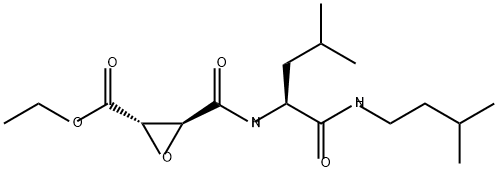Description
E-64d is an irreversible, membrane-permeable inhibitor of lysosomal and cytosolic cysteine proteases and has diverse biological activities. It is a synthetic analog of E-64 and prodrug form of E-64c that inhibits calpain and the cysteine proteases cathepsins F, -K, -B, -H, and -L. E-64d (20-200 μM) induces cell cycle arrest at the G
2/M phase in A431 human epidermoid carcinoma cells. It inhibits protease-resistant prion protein accumulation in scrapie-infected neuroblastoma cells with an IC
50 value of 0.5 μM. E-46d also inhibits entry of vesicular stomatitis virus (VSV) particles pseudotyped with severe acute respiratory syndrome coronavirus (SARS-CoV) or SARS-CoV-2 spike glycoprotein into Vero cells, an effect that is reduced by expression of the serine protease TMPRSS2.
Uses
E-64d has been used as a lysosomal inhibitor in human acute promyelocytic leukemia NB4 cells and Huh-7?cells. It has also been used as a protease inhibitor in free calcium physiological tyrode solution for perfusion into the isolated heart samples.
Uses
E-64d is an inhibitor of cathepsins B and L as well as a potential inhibitor of calpain. E-64d has been shown to inhibit lysosomal proteases. E-64d has been used in combination with Prepstatin A to interfere with autolysosomal digestion. E-64d displays neurovascular and neuronal protective effects after focal cerebral ischemia in rats.
Definition
ChEBI: An L-leucine derivative that is the amide obtained by formal condensation of the carboxy group of (2S,3S)-3-(ethoxycarbonyl)oxirane-2-carboxylic acid with the amino group of N-(3-methylb
tyl)-L-leucinamide.
Biochem/physiol Actions
E-64d is an epoxysuccinyl peptide and an inhibitor of cysteine protease cathepsin B, calpains 1 and 2. E-64d by its cathepsin B protease inhibition functionality, may serve as a potential drug for treating traumatic brain injury (TBI) and Alzheimer′s disease (AD). It inhibits gametocyte surface antigen resulting in a decreased oocyst production in Plasmodium falciparum.
Safety Profile
Moderately toxic by intraperitoneal route. An experimental teratogen. Experimental reproductive effects. Mutation data reported. Whenheated to decomposition it emits toxic fumes of NOx.
References
1) McGowan?et al.?(1989),?Inhibition of calpain in intact platelets by the thiol protease inhibitor E-64d; Biochem. Biophys. Res. Commun.,?158?432
2) Wilcox and Mason (1992),?Inhibition of cysteine proteinases in lysosomes and whole cells; Biochem. J.,?285?495
3) Mizushima?et al.?(2010), Methods in mammalian autophagy research; Cell,?140?313




